Gas Pressure Sensor Based on BDK-Doped Polymer Optical Fiber
Abstract
1. Introduction
2. Preform Fiber Fabrication and Sensing System
3. Experimental Results and Discussions
4. Conclusions
Author Contributions
Funding
Conflicts of Interest
References
- Huang, J.; Zhou, Z.; Zhang, D.; Wei, Q. A fiber bragg grating pressure sensor and its application to pipeline leakage detection. Adv. Mech. Eng. 2013, 5, 590451. [Google Scholar] [CrossRef]
- Sengupta, D.; Sai Shankar, M.; Saidi Reddy, P.; Sai Prasad, R.L.N.; Srimannarayana, K. Sensing of hydrostatic pressure using FBG sensor for liquid level measurement. Microw. Opt. Technol. Lett. 2012, 54, 1679–1683. [Google Scholar] [CrossRef]
- Ahmad, H.; Harun, S.W.; Chong, W.Y.; Zukifil, M.Z.; Thant, M.M.M.; Yusof, Z.; Poopalan, P. High-sensitivity pressure sensor using a polymer-embedded FBG. Microw. Opt. Technol. Lett. 2008, 50, 60–61. [Google Scholar] [CrossRef]
- Tam, H.Y.; Pun, C.F.J.; Zhou, G.; Cheng, X.; Tse, M.L.V. Special structured polymer fibers for sensing applications. Opt. Fiber Technol. 2010, 16, 357–366. [Google Scholar] [CrossRef]
- Yi, L.; Changyuan, Y. Highly stretchable hybrid silica/polymer optical fiber sensors for large-strain and high-temperature application. Opt. Express 2019, 27, 20107. [Google Scholar] [CrossRef] [PubMed]
- Bonefacino, J.; Tam, H.-Y.; Glen, T.S.; Cheng, X.; Pun, C.-F.J.; Wang, J.; Lee, P.-H.; Tse, M.-L.V.; Boles, S.T. Ultra-fast polymer optical fibre Bragg grating inscription for medical devices. Light Sci. Appl. 2018, 7, 17161. [Google Scholar] [CrossRef]
- Silva-López, M.; Fender, A.; MacPherson, W.N.; Barton, J.S.; Jones, J.D.C.; Zhao, D.; Dobb, H.; Webb, D.J.; Zhang, L.; Bennion, I. Strain and temperature sensitivity of a single-mode polymer optical fiber. Opt. Lett. 2005, 30, 3129–3131. [Google Scholar] [CrossRef]
- Large, M.C.J.; Moran, J.; Ye, L. The role of viscoelastic properties in strain testing using microstructured polymer optical fibres (mPOF). Meas. Sci. Technol. 2009, 20, 2–8. [Google Scholar] [CrossRef]
- Yu, J.; Tao, X.; Tam, H. Trans-4-stilbenemethanol-doped photosensitive polymer fibers and gratings. Opt. Lett. 2004, 29, 156–158. [Google Scholar] [CrossRef]
- Marques, C.A.F.; Pospori, A.; Sáez-Rodríguez, D.; Nielsen, K.; Bang, O.; Webb, D.J. Fiber optic liquid level monitoring system using microstructured polymer fiber Bragg grating array sensors: Performance Analysis. In Proceedings of the 24th International Conference on Optical Fibre Sensors, Curitiba, Brazil, 28 September–2 October 2015. [Google Scholar]
- Liu, H.Y.; Liu, H.B.; Peng, G.D. Tensile strain characterization of polymer optical fibre Bragg gratings. Opt. Commun. 2005, 251, 37–43. [Google Scholar] [CrossRef]
- Yuan, W.; Stefani, A.; Bache, M.; Jacobsen, T.; Rose, B.; Herholdt-Rasmussen, N.; Nielsen, F.K.; Andresen, S.; Sørensen, O.B.; Hansen, K.S.; et al. Improved thermal and strain performance of annealed polymer optical fiber Bragg gratings. Opt. Commun. 2011, 284, 176–182. [Google Scholar] [CrossRef]
- Bischoff, F. Organic polymer biocompatibility and toxicology. Clin. Chem. 1972, 18, 869–894. [Google Scholar] [PubMed]
- Leal-Junior, A.G.; Diaz, C.A.R.; Avellar, L.M.; Pontes, M.J.; Marques, C.; Frizera, A. Polymer Optical Fiber Sensors in Healthcare Applications: A Comprehensive Review. Sensors 2019, 19, 3156. [Google Scholar] [CrossRef] [PubMed]
- Leal-Junior, A.; Frizera-Netoc, A.; Marques, C.; Pontes, M.J. A polymer optical fiber temperature sensor based on material features. Sensors 2018, 18, 301. [Google Scholar] [CrossRef]
- Cennamo, N.; Massarotti, D.; Conte, L.; Zeni, L. Low cost sensors based on SPR in a plastic optical fiber forbiosensor implementation. Sensors 2011, 11, 11752–11760. [Google Scholar] [CrossRef]
- Min, R.; Korganbayev, S.; Molardi, C.; Broadway, C.; Hu, X.; Caucheteur, C.; Bang, O.; Antunes, P.; Tosi, D.; Marques, C.; et al. Largely tunable dispersion chirped polymer FBG. Opt. Lett. 2018, 43, 5106. [Google Scholar] [CrossRef]
- Yi, M.; Shu, J.; Wang, Y.; Ling, H.; Song, C.; Li, W.; Xie, L.; Huang, W. The effect of porous structure of PMMA tunneling dielectric layer on the performance of nonvolatile floating-gate organic field-effect transistor memory devices. Org. Electron. Phys. Mater. Appl. 2016, 33, 95–101. [Google Scholar] [CrossRef]
- Cheng, X.; Onefacino, J.B.; Uan, B.O.G.; Am, H.Y.T. All-polymer fiber-optic pH sensor. Opt. Express 2018, 26, 14610–14616. [Google Scholar] [CrossRef]
- Bhowmik, K.; Ambikairajah, E.; Peng, G.-D.; Luo, Y.; Rajan, G. High-sensitivity polymer fibre Bragg grating sensor for biomedical applications. In Proceedings of the 2016 IEEE Sensors Applications Symposium (SAS), Catania, Italy, 20–22 May 2016. [Google Scholar]
- Hu, X.; Pun, C.-F.J.; Tam, H.-Y.; Mégret, P.; Caucheteur, C. Highly reflective Bragg gratings in slightly etched step-index polymer optical fiber. Opt. Express 2014, 22, 18807–18817. [Google Scholar] [CrossRef]
- Theodosiou, A.; Hu, X.; Caucheteur, C.; Kalli, K. Bragg Gratings and Fabry-Perot Cavities in Low-Loss Multimode CYTOP Polymer Fiber. IEEE Photonics Technol. Lett. 2018, 30, 857–860. [Google Scholar] [CrossRef]
- Xu, M.G.; Reekie, L.; Chow, Y.T.; Dakin, J.P. Optical in-fibre grating high pressure sensor. Electron. Lett. 1993, 29, 398–399. [Google Scholar] [CrossRef]
- Vilarinho, D.; Theodosiou, A.; Leitão, C.; Leal-Junior, A.G.; de Fátima Domingues, M.; Kalli, K.; André, P.; Antunes, P.; Marques, C. POFBG-embedded cork insole for plantar pressure monitoring. Sensors 2017, 17, 2924. [Google Scholar] [CrossRef] [PubMed]
- Bhowmik, K.; Peng, G.-D.; Luo, Y.; Ambikairajah, E.; Lovric, V.; Walsh, W.R.; Rajan, G. Experimental Study and Analysis of Hydrostatic Pressure Sensitivity of Polymer Fibre Bragg Gratings. J. Light. Technol. 2015, 33, 2456–2462. [Google Scholar] [CrossRef]
- Kleideiter, G.; Lechner, M.D.; Knoll, W. Pressure dependence of thickness and refractive index of thin PMMA-films investigated by surface plasmon and optical waveguide spectroscopy. Macromol. Chem. Phys. 1999, 200, 1028–1033. [Google Scholar] [CrossRef]
- Ladegaard-Pedersen, H.J. Measurement of the interstitial pressure in subcutaneous tissue in dogs. Circ. Res. 1970, 26, 765–770. [Google Scholar] [CrossRef]
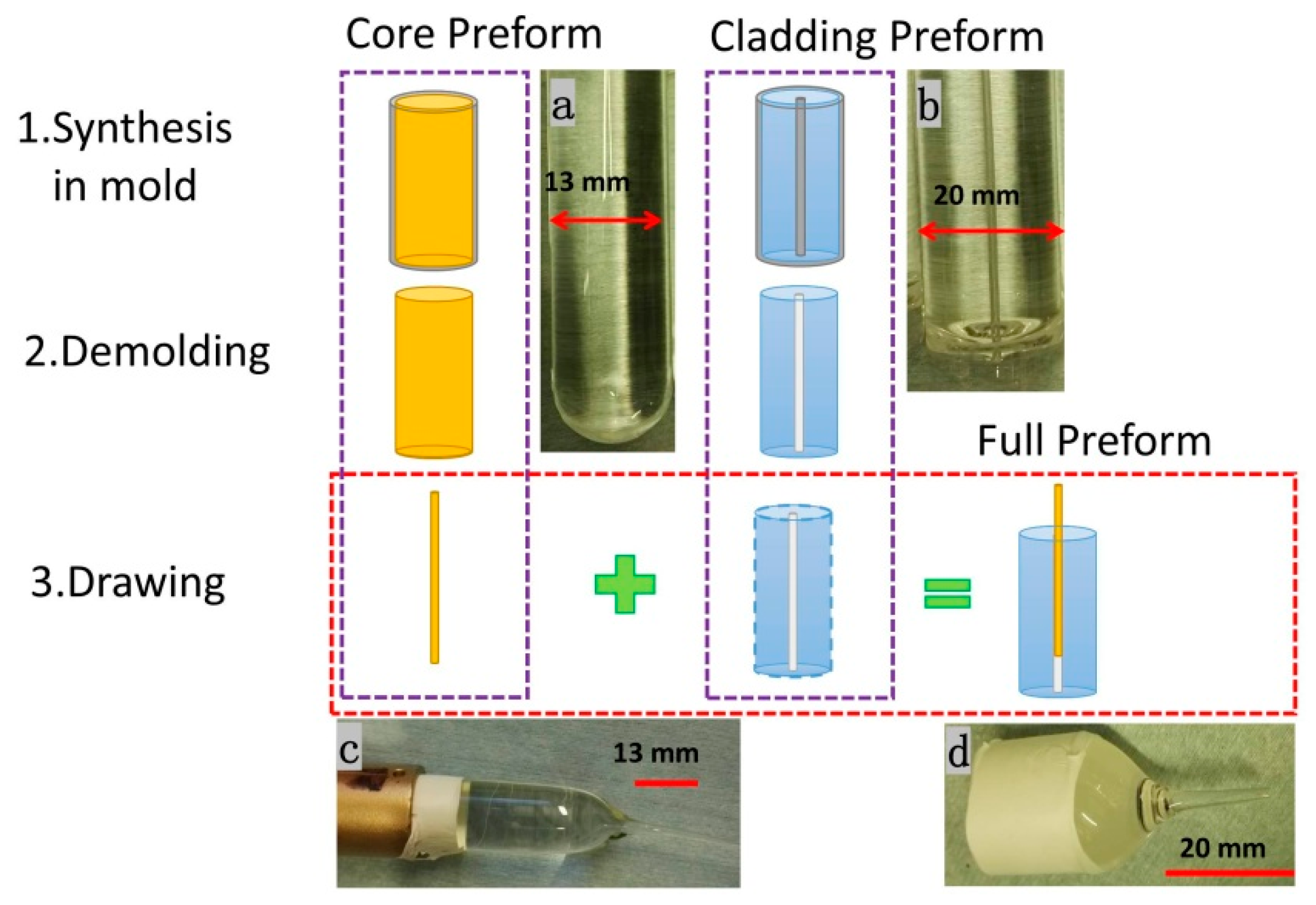

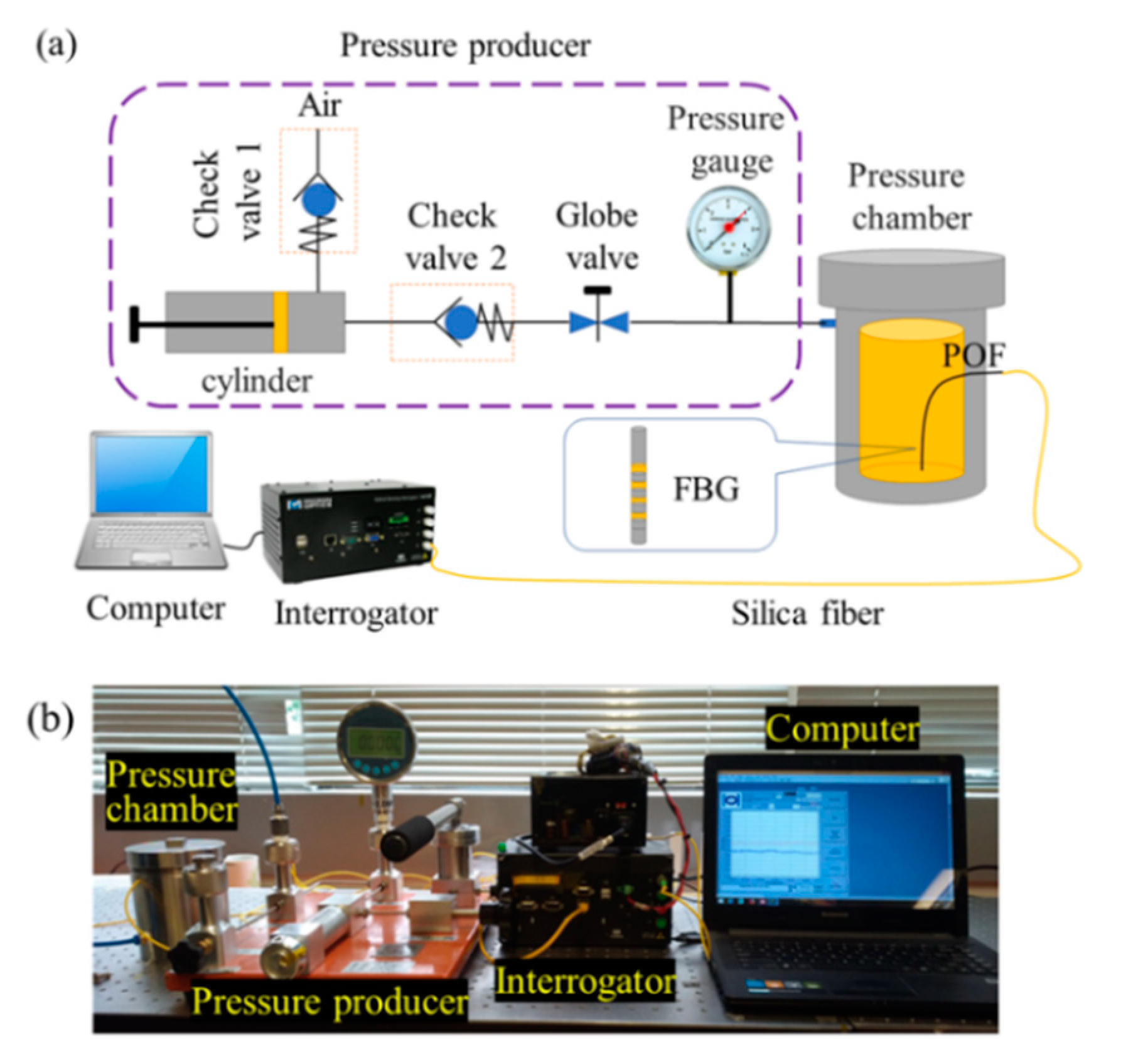
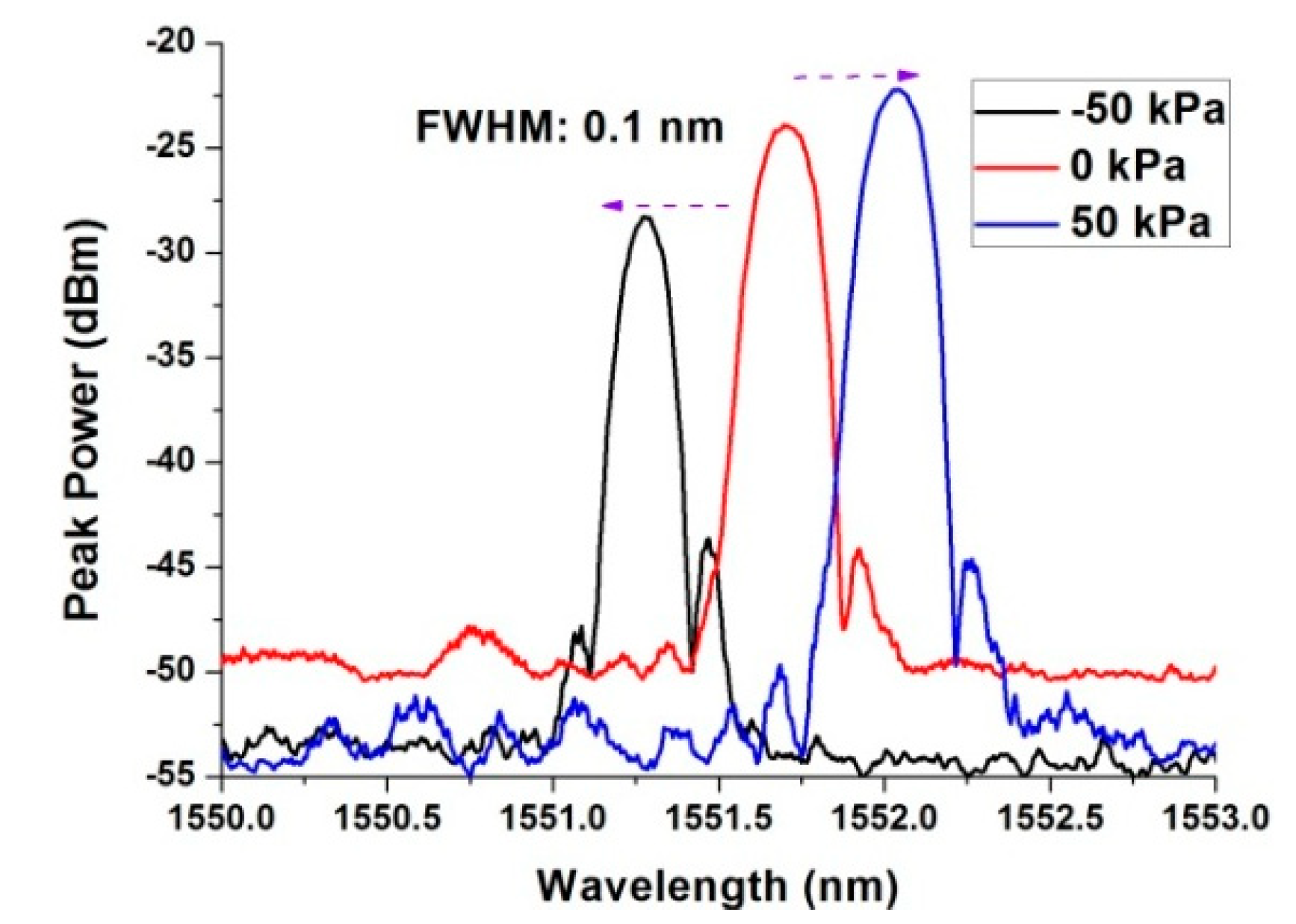
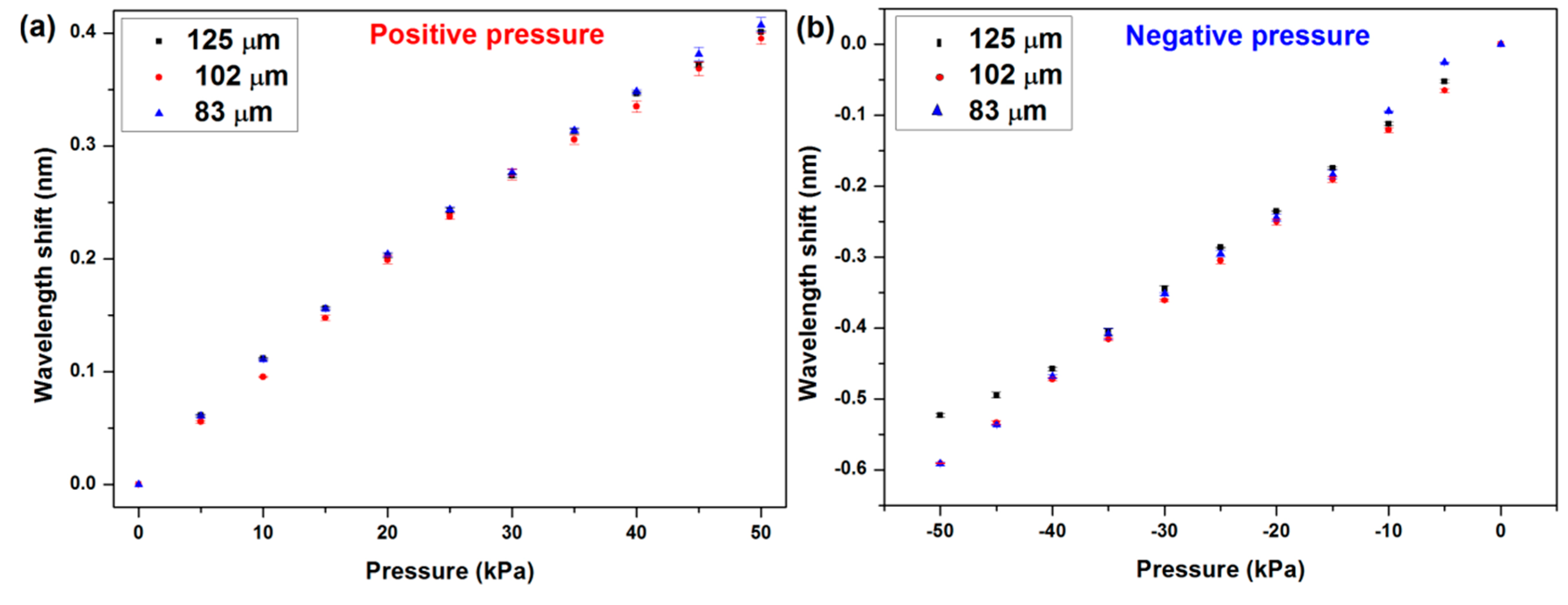
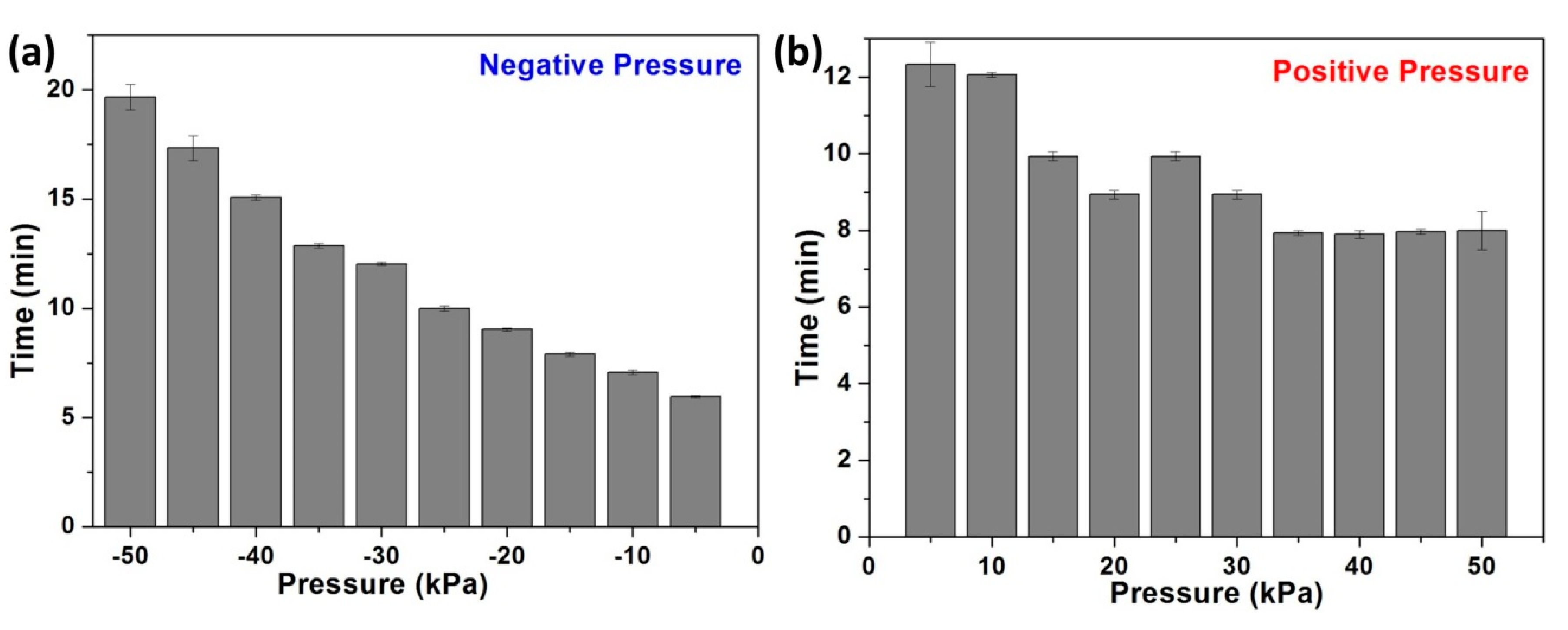
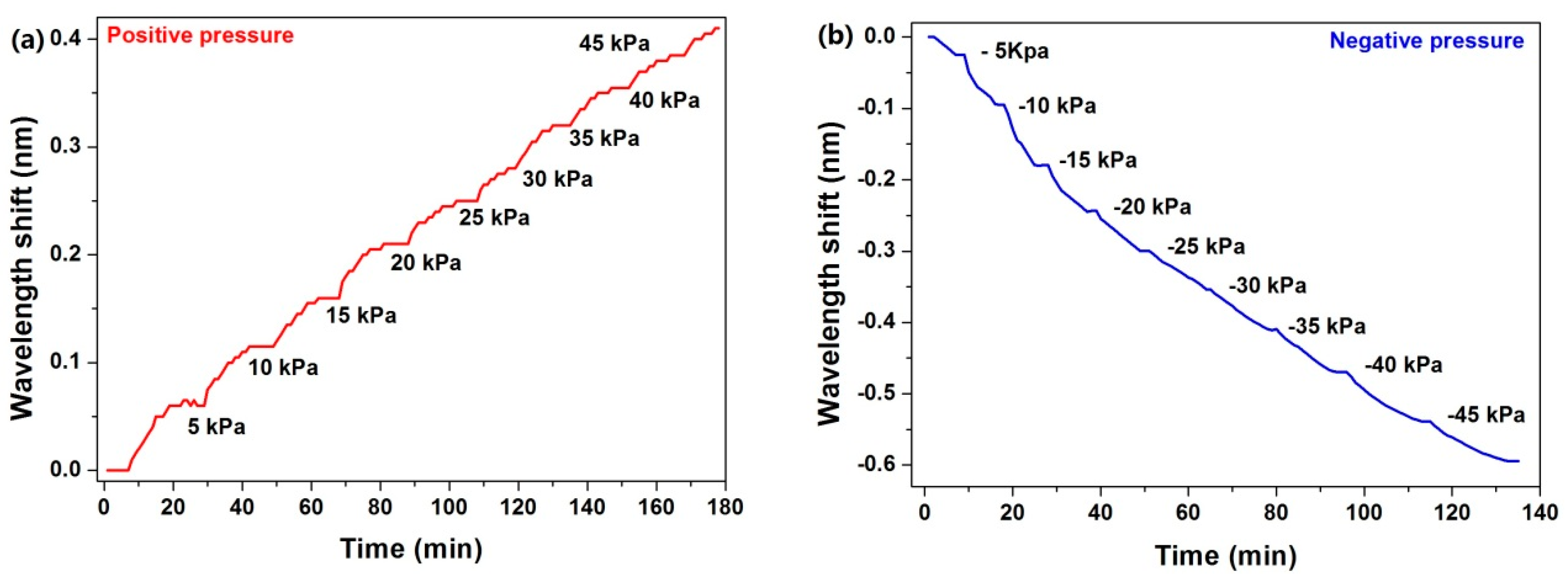
| Diameter | Sensitivity | |
|---|---|---|
| Positive Pressure | Negative Pressure | |
| 125 µm | 7.82 pm/kPa | 10.79 pm/kPa |
| 102 µm | 7.97 pm/kPa | 11.71 pm/kPa |
| 83 µm | 8.12 pm/kPa | 12.12 pm/kPa |
| Fiber | Sensitivity | Range | Reference |
|---|---|---|---|
| Single-mode silica fiber | 3.04 pm/MPa | 0–70 MPa | [23] |
| BzMA-doped core with PMMA cladding SMPOF | 200~750 pm/MPa | 0–1000 kPa | [20] |
| BDK-doped core with PMMA cladding SMPOF | ~7000 pm/MPa | 0–50 kPa | Present work |
| CYTOP multimode POF | 7710–8510 pm/MPa | 10–1500 kPa | [24] |
© 2019 by the authors. Licensee MDPI, Basel, Switzerland. This article is an open access article distributed under the terms and conditions of the Creative Commons Attribution (CC BY) license (http://creativecommons.org/licenses/by/4.0/).
Share and Cite
Cheng, X.; Liu, Y.; Yu, C. Gas Pressure Sensor Based on BDK-Doped Polymer Optical Fiber. Micromachines 2019, 10, 717. https://doi.org/10.3390/mi10110717
Cheng X, Liu Y, Yu C. Gas Pressure Sensor Based on BDK-Doped Polymer Optical Fiber. Micromachines. 2019; 10(11):717. https://doi.org/10.3390/mi10110717
Chicago/Turabian StyleCheng, Xin, Yi Liu, and Changyuan Yu. 2019. "Gas Pressure Sensor Based on BDK-Doped Polymer Optical Fiber" Micromachines 10, no. 11: 717. https://doi.org/10.3390/mi10110717
APA StyleCheng, X., Liu, Y., & Yu, C. (2019). Gas Pressure Sensor Based on BDK-Doped Polymer Optical Fiber. Micromachines, 10(11), 717. https://doi.org/10.3390/mi10110717






